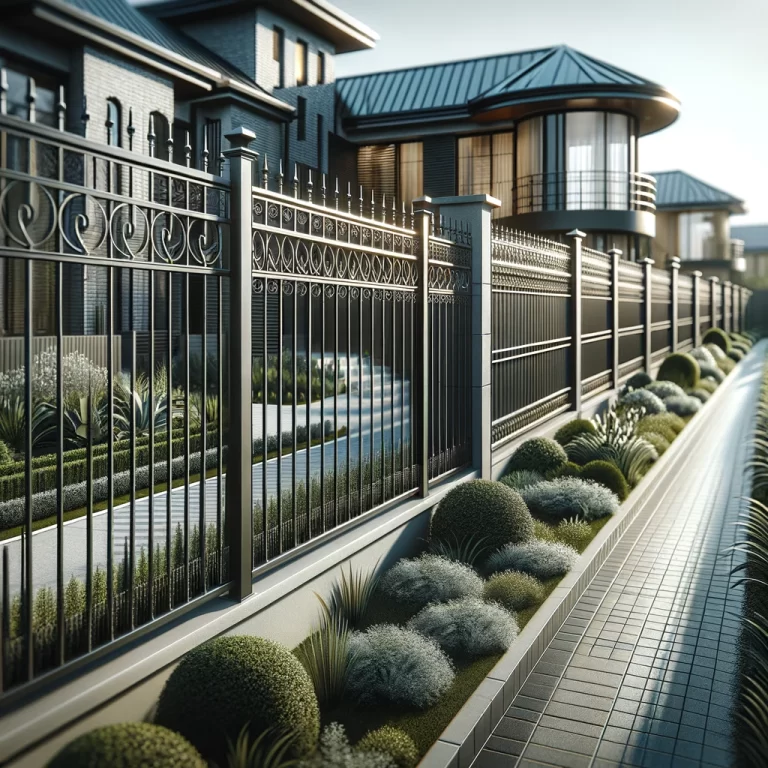Curious about property boundaries, fences, and the laws surrounding them? In this comprehensive article, we will explore the importance of understanding property boundary lines, the regulations for fence construction and maintenance, and how to navigate neighbourly disputes over fences. We will discuss the different types of fences, steps to take when facing opposition from a neighbour, and the process of resolving disputes over fences. Stay tuned to learn everything you need to know about property boundaries and fences.

What Is a Property Boundary?
A property boundary defines the limits of a land parcel, indicating the area that a property owner legally possesses. These boundaries play a crucial role in determining ownership rights and responsibilities.
The accurate demarcation of property boundaries is essential to establish ownership status and prevent conflicts with neighbouring landowners. Clear boundaries help in avoiding disputes regarding land use, access rights, and potential encroachments.
Entities like the Land Registry maintain official records of property boundaries, ensuring transparency and legal certainty. In case of boundary disputes, these organisations provide a framework for resolution, often involving surveys, legal documentation, and expert testimonies to clarify ownership boundaries.
What Is a Fence and Why Is It Important?
A fence serves as a physical barrier that demarcates a boundary or property line, providing privacy, security, and aesthetic appeal to the property. Understanding the importance of fences in maintaining property boundaries is essential for property owners.
Fences play a crucial role in enhancing the visual appeal of a property while creating a safe and private environment for the occupants. Properly installed fences not only delineate spaces but also act as a deterrent to intruders, safeguarding the property from unauthorized access. Well-maintained fences contribute to the overall value of the property by adding a sense of completion to the landscape and ensuring the boundaries remain intact over time.
What Are the Laws Regarding Property Boundaries and Fences?
The laws governing property boundaries and fences encompass various legal provisions related to boundary disputes, ownership rights, planning permissions, and building regulations. Understanding these legal frameworks is crucial for property owners to navigate boundary-related issues.
In property ownership, the demarcation of property boundaries is fundamental and legally binding. Boundary rules dictate the rights and responsibilities of adjoining landowners, determining the exact limits of their properties. These rules also outline the requirements for installing and maintaining fences along property lines.
When considering erecting a fence, property owners must be aware of planning permissions and building regulations. Certain types of fences may require approval from local authorities to ensure compliance with established norms and standards to avoid legal implications.
Understanding Property Boundary Lines
Property boundary lines delineate the area of land ownership and are typically documented in deed plans. Understanding the significance of boundary lines is essential to prevent boundary disputes and potential legal issues.
One crucial aspect related to property boundary lines is the concept of adverse possession. This legal principle allows individuals to claim ownership of a property if they have openly and continuously used it for a certain period, usually several years, without the actual owner asserting their rights. This can result in significant complications and disputes, underlining the vital importance of clear and accurate demarcation in deed plans.
Laws on Fence Construction and Maintenance
Laws governing fence construction and maintenance dictate aspects such as permissible fence height, maintenance responsibilities for shared fences, requirements for fence repair, and regulations for building new fences. Adhering to these laws is vital for property owners to avoid legal issues.
Property owners must ensure that the height of their fences complies with local regulations, as exceeding the allowed height can lead to fines or orders for removal. Painting regulations may also come into play, specifying colours or finishes permitted for fences visible from public areas.
Regarding shared fences, neighbours have joint responsibilities for upkeep and repair, making communication key to resolving any disputes. Timely fence maintenance and repair are crucial not only for aesthetic reasons but also for safety and property boundaries.
Neighborly Disputes over Fences
Neighbourly disputes over fences often arise due to conflicting ownership claims, boundary disagreements, or maintenance issues. Resolving these disputes may involve legal intervention, mediation, or seeking advice from boundary disputes experts.
- Ownership disputes typically occur when neighbours have differing opinions on who is responsible for the maintenance and upkeep of the fence. This can lead to arguments over shared costs and obligations, further escalating the conflict.
- Boundary disagreements, on the other hand, can result from unclear property lines or inaccurate land surveys, causing confusion and tension between neighbours. Such disputes often require expert assessment to determine the accurate boundaries and resolve the issue amicably.
- In cases where direct communication fails to resolve the conflict, seeking mediation services can be a proactive approach to finding a mutually acceptable solution. Mediators can help facilitate discussions, negotiate agreements, and assist in finding common ground among the parties involved.
What Are the Different Types of Fences?
Fences come in various types, including privacy fences that offer seclusion, decorative fences that prioritize protection. Understanding the different fence types helps property owners select the most suitable option for their needs.
Privacy fences are typically taller and solid, blocking the view from outsiders and providing a sense of solitude. On the other hand, decorative fences come in various styles like picket fences or wrought iron designs, adding charm and character to a property. Regarding security fences, their primary role is to deter intruders and ensure the safety of the premises.
Privacy Fences
Privacy fences are designed to offer seclusion and limit visibility, typically featuring a significant height to maintain privacy. Incorporating elements like trellises or boundary features can enhance the aesthetics and functionality of privacy fences.
Height restrictions for privacy fences vary depending on local zoning laws, with many areas allowing fences up to six feet tall. Design variations range from classic wooden panels to modern metal structures, offering homeowners a choice to match their property aesthetic. Trellises can be added on top of fences to support climbing plants, further increasing privacy and adding a natural touch to the barrier.
Decorative Fences
Decorative fences add aesthetic appeal to properties, with options for intricate designs, colours, and materials. Proper fence painting and maintenance are essential to preserve the decorative elements and reflect shared ownership responsibilities where applicable.
When considering design choices for decorative fences, homeowners often lean towards ornamental wrought iron or charming picket fences for a traditional touch. Alternatively, modern properties may opt for sleek metal fences or minimalist wooden designs. Choosing the right colour for the fence is crucial, as it should complement the overall exterior aesthetic without clashing with the surroundings.
Regular maintenance, such as cleaning, repainting, and treating the wood or metal, is vital to prevent deterioration and maintain the fence’s appearance. When decorative fences are a shared feature between neighbouring properties, clear agreements regarding upkeep and repairs must be established to avoid disputes and ensure proper maintenance.
Security Fences
Security fences are intended to provide protection and deter unauthorised access, featuring robust construction and security measures. Ensuring proper installation and addressing any hazardous or shared wall issues is crucial for effective security fencing.
Regarding the characteristics of security fences, they are designed to act as a physical barrier that safeguards property boundaries and restricts access to authorised individuals. These fences often incorporate features such as barbed wire, electrification, or surveillance systems to enhance their protective capabilities. Security fences are typically constructed using durable materials such as steel or concrete to ensure longevity and resilience against external threats.
One of the primary purposes of security fences is to maintain the privacy and security of a property, deterring intruders and protecting valuable assets from theft or vandalism. Properly installed fences serve as a visible deterrent, signalling to potential trespassers that the property is secure and out of bounds. Plus preventing unauthorised access, security fences can also define property boundaries and reduce the risk of boundary disputes between neighbouring properties.

Can My Neighbor Stop Me from Building a Fence?
Property owners planning to build a fence should consider their legal rights and obligations, including obtaining necessary planning permissions and addressing potential objections from neighbours. Understanding the regulations and communication strategies is key to successful fence construction.
Regarding legal considerations, it is crucial to adhere to local zoning laws and building codes to ensure compliance. Consulting with a property attorney or a land surveyor can provide valuable insights into property boundaries and potential easements that may affect fence installation.
Effective communication with neighbours is essential to mitigate conflicts that may arise during construction. It is recommended to discuss fence plans with neighbours early on to address any concerns they may have and maintain a positive relationship.
Checking Property Boundaries
Before erecting a fence, verifying property boundaries through boundary marks and legal documents is crucial to avoid boundary disputes. Resolving boundary issues proactively can prevent conflicts and maintain privacy.
Using physical boundary markers like fences, walls, or hedges can also provide clarity on where the property lines lie.
Consulting with a land surveyor can help accurately demarcate the boundaries, ensuring that the fence is built in the correct location.
It is essential to communicate openly with neighbours about the planned fence installation, discussing any potential boundary issues beforehand. Keeping the lines of communication open can help resolve any concerns or disagreements amicably.
Obtaining Necessary Permits
Securing the required permits from the planning office and complying with building regulations are essential steps before erecting a fence. Seeking legal advice on boundary demarcation and regulations can aid in avoiding legal complications.
When embarking on a project to construct a fence, it is crucial to navigate the intricate realm of permits and regulations. Obtaining the necessary permits involves submitting detailed plans to the local planning office for approval.
Meeting building regulations ensures that the fence is safely constructed and does not infringe on any zoning ordinances.
Legal advisors play a crucial role in this process, providing guidance on boundary demarcation requirements and ensuring compliance with the legal frameworks that govern fence installation.
Communicating with Your Neighbour
Open communication with your neighbour about fence construction plans can help in addressing concerns and reaching mutually beneficial agreements.
Ensuring clarity in regards to property boundaries and construction details can avoid misunderstandings and potential conflicts. Communicating openly can lead to mutual respect and understanding, creating a positive environment for cooperation. When disputes arise, involving mediators or solicitors can provide a structured approach to finding common ground. These professionals are adept at facilitating discussions and guiding parties towards solutions that uphold legal boundaries.
Exploring compromise options, such as adjusting the fence location or sharing costs, can often lead to amicable resolutions. Establishing boundary agreements with legal validity can offer long-term clarity and prevent future disputes. Prioritising transparent communication and respectful negotiation fosters good neighbourly relationships and promotes a harmonious living environment.
What Are the Steps to Resolving a Dispute Over a Fence?
Resolving a fence dispute may involve mediation, legal action, or reaching a compromise to address conflicting interests. Seeking advice from property disputes specialists or legal experts can provide valuable insights and support in resolving disputes effectively.
Mediation is often the initial step in resolving fence disputes, encouraging both parties to communicate and find common ground. A mediator, acting as a neutral third party, assists in facilitating constructive discussions and exploring potential solutions.
If mediation fails to produce a resolution, legal action may be necessary, with each party presenting their case before a court. Negotiation plays a crucial role, allowing parties to discuss potential agreements and come to a mutually acceptable outcome.
Mediation
Mediation offers a structured process for neighbours to discuss fence disputes with the assistance of a neutral mediator.
Involving council mediators or professional mediators can be highly beneficial in these situations. Council mediators, often provided by local authorities, bring a deep understanding of local regulations and norms, which can streamline the resolution process. On the other hand, professional mediators specialising in neighbourly disputes possess a wealth of expertise in conflict resolution techniques, ensuring that the dialogue remains focused on finding mutually agreeable solutions. By leveraging their skills, neighbours can navigate complex issues related to property boundaries, encroachments, or maintenance responsibilities with clarity and fairness.
Legal Action
When fence disputes escalate, legal action may be necessary to clarify ownership rights and resolve boundary issues. Seeking legal opinions from boundary experts or consulting with legal authorities like High Court Judges can provide clarity and guidance in complex disputes.
Boundary experts play a crucial role in evaluating property boundaries, reviewing titles, and interpreting local laws to ascertain ownership rights.
Legal proceedings often involve presenting evidence such as property documents, surveys, and testimonies to support one’s claim. Expert guidance can help individuals navigate the intricacies of property law and ensure their rights are protected.
By involving legal authorities, individuals can access avenues for dispute resolution, including mediation, arbitration, or court proceedings if necessary. These steps can lead to a formal legal resolution to fence disputes, establishing clear boundaries and ownership rights.
Compromise
Finding a compromise with neighbours on fence-related issues can lead to mutually acceptable solutions that respect shared boundaries. Drafting boundary agreements and seeking approval from legal entities like County Court Judges can formalise compromises and prevent future conflicts.
When both parties are willing to collaborate and reach a compromise, it not only fosters a sense of mutual respect but also avoids the escalation of conflicts. By having a written boundary agreement in place, clearly outlining property lines and responsibilities, neighbours can establish a foundation for resolving disputes amicably.
This agreement, once validated by a County Court Judge, carries legal weight, providing a formal recognition of the compromise and ensuring adherence to the agreed-upon terms. Such legal validation acts as a safeguard, preventing misunderstandings and boundary disputes in the future.




